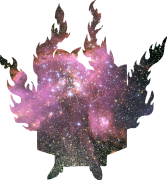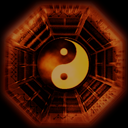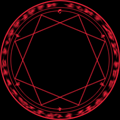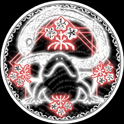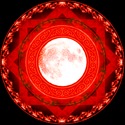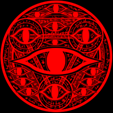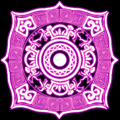The Whispered Oracle Situation
Whispered Oracle of Hakurei Shrine is, as of writing this on April 20th 2025, the latest official Touhou printwork. There’s been quite a number of various Touhou printworks, from manga to collections of in-universe news to the deeply fascinating Symposium of Post-Mysticism that elaborated on the functioning of the world of Gensokyo to the deeply puzzling Grimoire of Marisa with it’s sigils.
Whispered Oracle has landed itself squarely into the more fascinating corner of Touhou printworks by the virtue of being a fully canonical, fully functional Touhou fortune telling book based on the omikuji system with instructions on how to use it. It comes with a interesting little narrative that frames it both in fiction and perhaps even in real life. There’s surprising amounts of depth to this framing and certain weird elements surrounding the book itself and it’s release. It continues ZUN’s tendency of playing around with themes and practices related to Japan’s majority religions.
While ZUN himself tells the reader not to take the book too seriously, we are going to discard that advice and take a deep dive into the Whispered Oracle. We’ll begin by looking at what exactly are the omikuji, the themes around the narrative framing of the book and how it might tie to real life, the differences between divination and fortune telling, some strange circumstances surrounding the release of the book and how this all ties together to make the Whispered Oracle a kind of a ritual performed both in-fiction but also in real life.
As the majority of the book remains untranslated, this article focuses on the broad strokes. There is still more than enough of interest to focus on in the big picture. Let us start by looking at what exactly is the omikuji.
Omikuji
Omikuji or O-mikuji (”sacred lot”) is a form of fortune-telling practiced by Shinto shrines and Buddhist temples in Japan. They are usually received by making a small offering and randomly choosing a paper strip from a box. They are one of the traditional activities of a shrine or temple visit. ZUN himself says in the afterword of the book something to the effect that for most of modern Japanese, the omikuji are a ”random way to pass time”.
The omikuji are commonly classified by how good or bad fortune they promise for the one who has drawn them. Generaly they are ranked from Misfortune to Great Blessing in a seven step scale. There are also variations which add more ranks, such as ”blessing and fortune undetermined”, where the fortune depends on the receiver’s actions. In addition to the general outlook, omikuji offer more specific fortunes for various fields of life. These can include things like travel, business, romance, studies, disputes, health and so on.
When the fortune is bad, it’s customary to tie the omikuji paper slip to a nearby pine tree or a wall of metal wires found on the temple or shrine grounds. The reason for the tree being specificaly a pine tree is supposedly based on ”pine tree” and ”to wait” being both ”matsu” in Japanese, and that the bad fortune would ”wait” by the pine tree. If the fortune is good, the fortune can be taken home or also be tied.
The omikuji are thought to have originated from kau chim, a similar form of fortune telling from China. The most common form of omikuji used in Buddhist temples, known as the Ganzan Daishi Hyakusen (”Ganzan Daishi’s One Hundred Lots), has an interesting tie to Nagano, a preferecture in Japan with many ties to Touhou lore. The Ganzan Daishi Hyakusen was popularized by the monk Tenkai. It is told that Tenkai was in his dreams visited by the spirit of Ryogen, a very notable figure in the history of Tendai Buddhism, who then revealed to Tenkai the hundred poems used in this form of omikuji. These revelead poems had been supposedly lost for centuries. Eventually, copies of these short poems were discovered at the Togakushi Shrine in Nagano. After that, they became widely disseminated.
How to draw your fortune
It needs to be stated outright that the Whispered Oracle of Hakurei Shrine is fully functional for use, and comes with instructions. This is 100% functional, 100% canonical Touhou fortune telling book. As there are no currently translated instructions, I will provide them here.
The methods include the traditional method of using paper stripes. The user makes 128 paper slips, puts them into a box and picks at random. Less laborous methods are also given. These include tossing seven coins – a technique somewhat reminescent of the three coin method often used with I Ching – and rolling six or eight-sided die.
The seven coin method has the user arrange seven coins into a row. Then, the coins are attributed values from left to right as follows: 64, 32, 16, 8, 4, 2, 1. The user must decide if throwing heads or tails gives this value. When the opposite result is given, it counts as a zero. After making the decision, the coins are thrown and the result is tallied up. Then, 1 is added to the final result.
In this example, heads has been atributed the value and tails the zero. The following throw
T-H-T-T-H-H-T
would then result in
0-32-0-0-4-2-0 = 38
to which +1 is added, which gives us 39 as the end result, which is the number of the omikuji to check from the book.
The eight sided die has the user throw the die three times. The results are memorized. Then, the following formula is applied:
If first throw is even, the number is 0. If the first throw is odd, the result is 64.
Second number is multiplied by eight and added to 64 or 0.
Third number is reduced by -8 and added to combined results of first two outcomes.
Example per book:
Results are 7, 3 and 6.
7 is odd and the result is 0.
This leads to 0 + (3 x 8) + 6 – 8 = 22
The six sided die also has the user roll the die three times and memorize the numbers. During the first roll, the user seeks a number between 1-4 and rerolls if it’s 5 or 6. The rest of the rolls are normal between 1 and 6. After that, the result is put into the following formula:
(1st result x 36) + (2nd result x 6) + 3rd result -42.
Example per book:
Results are 2, 5 and 1.
This leads to (2x36) + (5x6) + 1 – 42 = 61.
There is an 11% chance of getting 129 or higher as a result from this method, at which point the user has to reroll them.
ZUN also states that there are other ways to do the process, and encourages users to get creative. I personally think that doing straight up bibliomancy (open a page at random) could work as a very quick method. It’s also likely possible to adapt the three coin I Ching hexagram casting method, as it produces a result between 1 and 64, and then using a final, independent coin toss to decide whether the result is 1x or 2x, giving it the space of possibility for generating results between 1 and 128.
Framing of the book – Return from the Mu
Beyond being a fortune telling book, the Whispered Oracle of Hakurei Shrine also comes with a story that serves as a framing device. The small story ties in to the events of Unconnected Marketeers and Unfinished Dream of All Living Ghost and is actually rather interesting for those with familiarity in certain Japanese beliefs.
The events of Whispered Oracle start when Nippaku Zanmu arrives at the Hakurei Shrine, and tells Reimu that the youkai of Gensokyo are at risk of losing their character, and therefore they might undergo changes or disappear entirely. Youkai who are described as being ”only connected to the world spiritually” and who don’t have much contact with humans are especially at a risk of disappearing alltogether.
The cause for this loss of character is the loss of land ownership in Gensokyo. This happened due to Tenkyuu Chimata ”returning things to nothing” during the events of Unconnected Marketeers. This very same incident provoked the conflict depicted in Unfinished Dream. Zanmu presents herself as an expert in this ”nothing”, or mu, and even though she tells Reimu to not take her too seriously, Reimu finds herself compelled to act, especially after Zanmu calls her the ”ruler of Gensokyo”.
Setting aside the most obvious angle of the narrative being part of a longer arc, something which ZUN has been doing more and more as time passes, there’s quite a number of interesting things to look at here.
The first thing to pay attention here is this nothing, or mu, that Chimata-sama has returned things to for Gensokyo. Ideas related to ”nothing” being a kind of a substance or thing or shaping force in itself are present widely in Asian culture. This fascination with ”nothing” is of dual origin. Both the Indians and the Chinese – likely independently – developed a fascination with invisible aspects of reality, and began using terms that translate to things like ”emptiness” or ”nothingness” to describe these aspects. In both cultures, these ideas of ”emptiness” are also linked with meditation practice and insight gained from it.
The topic is more than deserving of it’s own article, and I am of less than perfect understand of the topic myself. Suffice to say, the ”emptiness” and ”nothing” is however not some nihilistic non-existence, death, dissolution or destruction. What exactly it is depends on the tradition, and processes of cultural exchange created conceptualizations that seem to blend together ideas of both Chinese and Indian origin. Ideas drawing from both Indian side via Buddhism and China via Taoism and it’s influence on later developments of Buddhism entered Japan. While the subject is more than deserving of an article of it’s own, a brief overview here is necessary for context.
In Mahayana Buddhist view, ”emptiness” can perhaps be summed up as follows: All phenomena are without an unchanging nature unto themselves. All phenomena come into existance and are shaped by vast chains or causation and interdependence. Because all phenomena are in a constant state of interdependent change and becoming and lack an inherent nature unto themselves, they are ”empty”. Humans however have a tendency to project qualities of inherent nature and separation into phenomena, making them in a sense ”illusionary” as these qualities do not exist in the ineffable unseparated baseline reality. Becoming enlightened or awakened would allow one to perceive this unseparated baseline reality as it is.
In Mahayana Buddhism, there is a strand of thought which links enlightenment to this ”emptiness” of baseline reality itself. Buddha, the awakened one, is not seen as merely the historical Shakyamuni Buddha, but rather as Buddha-nature present in all sentient things, in some interpretations in all things. This all-inclusive interpretation leads to a rather startling conclusion: all of reality is pervaded by some form of consciousness that is struggling to perceive itself with clarity.
In traditions of Chinese origin, such as Taoism, emptiness is used to described both a number of processes that have an impact on the world while being imperceptible, but also as a state of primordial undifferentiated being. The Tao of Taoism is famously described as being impossible to be directly perceived. Instead, it’s influence and workings on the world can only be seen via inference. At the same time the Tao generates everything manifest in the world, and thus by studying the non-manifest features of reality it’s possible to discover the Tao and therefore how the world works.
The Chinese believed that everything in the world is animated by qi, a kind of ”breath of life”, and that this ”nothing” gave qi space to operate while also finding it’s way into things. Various liminal phenomena – borderlines, holes, gates and so on – were though to be places where this ”nothing” was most manifest and where it’s influence could be most strongly perceived. Following ths line of thinking, in some ways the world becomes an inverse picture of how we perceive it in everyday reality: a jar is clay with ”nothing” in it that makes it function, a forest is defined by it’s ”nothing” that makes trees stand apart, a breath is movement of air separated by ”nothing” into exhalation and inhalation and music and speech are sound which are cleaved into meaningful pieces by ”nothing”.
Which one of these are ZUN’s ideas of ”nothing” closer to? Well, to be completely honest, neither really. The concepts of ”nothing” in Asian culture are very difficult, and there are some aspects of how ZUN uses it that leans towards a rather nihilistic interpretation of it as ”non-existence”. But there are certain echoes from these traditions in how it is depicted, as well as a small interesting twist of his own.
The ”nothing” that Gensokyo got returned into most definitively was not some sort of a state of non-existence, or the series would have ended with Unconnected Marketeers. Rather, it seems that whatever Chimata did returned Gensokyo to a kind of undifferentiated state of potential, where it’s possible to re-define land ownership and even the nature of it’s inhabitants in itself. This crisis of potential has allowed for Gensokyo to re-define itself, albeit in a way that seems to re-create the old status quo, but with new actors in it.
It’s this crisis, resolution as well as ”returning to nothing” being explained with furigana as ”returning to kami” that we got that interesting twist of ZUN’s own that makes this ”nothing” a very Japanese thing.
The Whispered Oracle Omikuji as a ritual
The Whispered Oracle omikuji – both in fiction and possibly in real life – is essentially a Shinto ritual that is used to return Gensokyo from a state of crisis and uncontrolled change to a state of new normal by re-defining the identity of it’s inhabitants.
This idea of renewing and re-stabilizing society and status quo through rituals is an idea that echoes broad Japanese cultural and spiritual sentiments. It has been written that various Shinto rituals act as a kind of a return to an eternal, primordial, timeless time, repeating certain acts as they have played out since immemorial times. At the same time Shinto is very much focused on growth and renewal – these rituals don’t serve to put the community into a stasis, but rather to steer the eternal process of life expressing itself.
This tension between conserving what exists and renewing it likely has it’s roots to how prone Japan is to natural disasters. Even the mightiest human creations have to be accepted as temporary and provisional and unstable circumstances. Society can not be laid in stone if stone can crumble in earthquakes or be topled by typhoons or tsunami. Thefore, the community must find more insubstantial means to carry on it’s heritage. Rituals offer a way to connect with numinous and ancestral forces that have guided the community since ancient times, yet these forces are not one of stasis either. The mythologies of Kojiki and Nihon Shoki are dynamic, full of conflict – and yet also the resolution of these conflicts and the creation of a new kind of order.
Gensokyo exists by ZUN’s own admission in a kind of a state where time does not advance as it does in outside world, yet it is not a static, unchanging one. There are incidents, but after every incident – perhaps analogous to a natural disaster – a new status quo that adapts itself to new inhabitants and influences emerges after a kind of class of ritual specialists resolve the incident.
It’s extremely noteworthy that the way to resolve this particular incident is to essentially restate the nature of Gensokyo’s inhabitants. By placing names and characteristics upon things you pull them out of the undifferentiated state of limitless potential of ”nothing” and turn them into something. All of Touhou’s canon plays heavily with this idea of how belief, perception and categorization shape things, so this is very much refinement of these ideas.
Reimu’s solution to the crisis is in some ways an anthithesis of the Buddhist and Taoist pursuit of the undifferentiated reality, yet it can also be seen as something that is harmonious with broader ideals of these traditions too. Both Mahayana Buddhism and Taoism place emphasis that any kind of attainments must be put into use for the broader community. After enlightenment one must come down from the mountain and be of use to others. And the pursuit of ”nothing” is not meant for the unready. If one mistakes ”nothing” for ”non-existence”, what could be limitless potential might become death.
It also needs to be stated that Reimu’s ritual is truly all-encompassing (at least in the context of the Windows canon). There is no being that is too trivial, weak, difficult, hostile, unwanted or even dangerous to the existence of Gensokyo to be excluded from the scope of the omikuji. She did not conveniently forget some particularly loathsome youkai in hopes of making them disappear. If you truly think about it, it’s an incredible work of compassion.
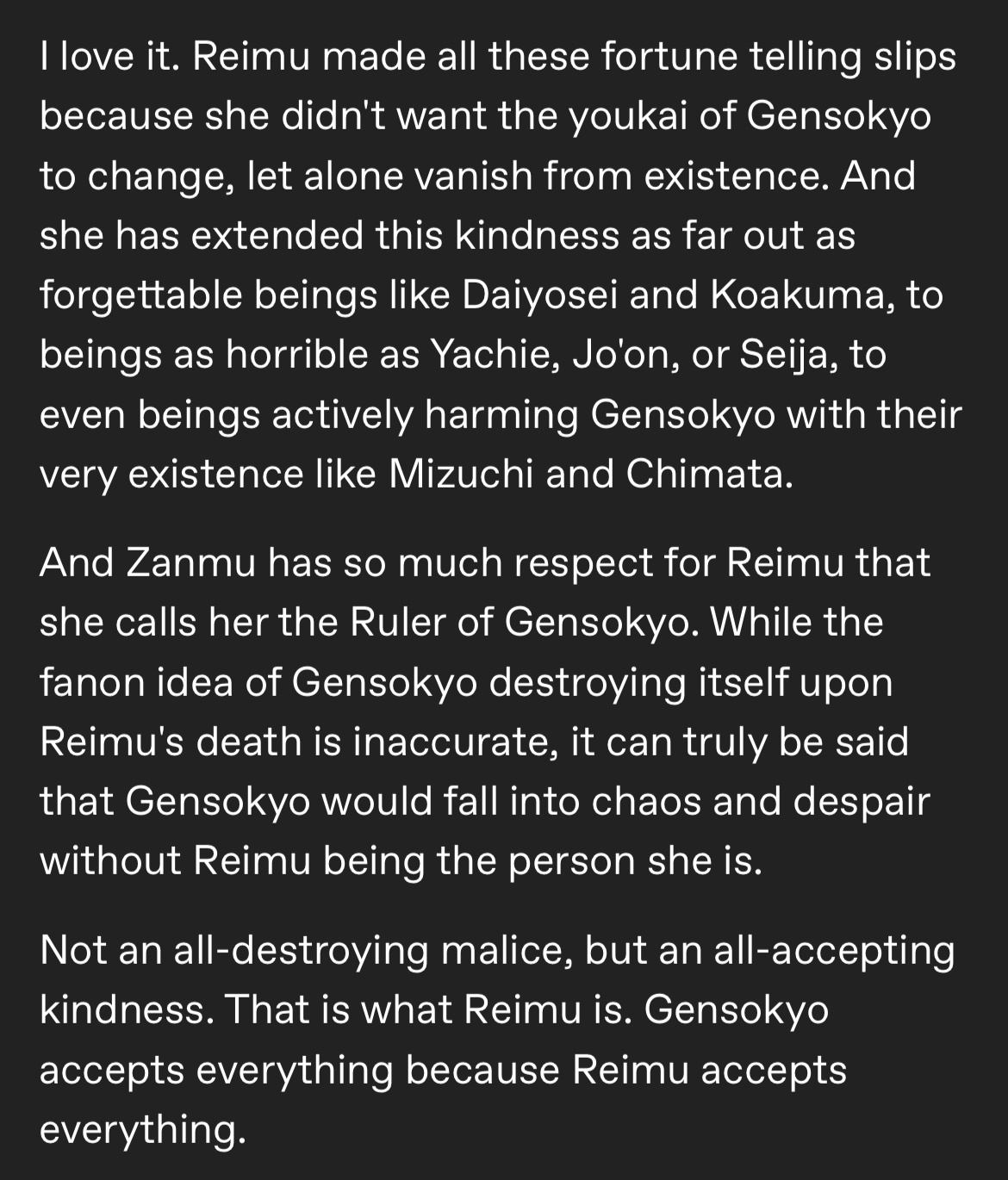
Reimusattva.
Let’s return to that ”in real life” aspect for a while. The real life implications here of course are that ZUN released new material encompassing the Windows canon of characters, thus reinforcing them as the current, given cast. The fortunes – which we will be looking a bit more closely next – are also an opportunity to restate and perhaps in some cases re-define who these characters truly are.
This all has of course some pretty mundane fandom implications. There’s new material for characters that haven’t really been written about in ages. There is new canon material in general. The community has once again come together, renewed it’s bonds over the shared love for the inhabitants of Gensokyo. The release of the Whispered Oracle brought an influx of new energy and interest and wrapped up an old narrative line. This prepares the ground and brings attention for the next big release which is indeed a big one – Touhou 20. The demo of the next mainline game is set be released in the next Reitaisai, and this closure of a narrative arc serves as a way to clear up plotlines and energies that were getting stale.
If you want to take the view that the spirits of Gensokyo are real, it opens up some questions. Does this book serve a kind of renewal for them? Are they defined, perhaps even conjured into existence, by our perceptions as Touhou canon would have it be? And what does this new framing, drawing more from real-life spiritual traditions exactly mean? Do they want to propagate religious or magical practices to the fandom? Do the omikuji possibly serve as a form of communication? At this point there are more questions than answers and only time will tell what is the true meaning of this strange ritual.
Character Fortunes or Fortunes for Characters?
While it appears that the fandom at large hasn’t quite grasped the full implications of this book, there has been a kind of implicit debate going on whether the omikuji are for the characters in the sense that the given fortunes predict outcomes for them, or if the omikuji in a way contain the nature of a character, and thus the fortunes given out do no necessarily apply to the characters themselves.
The narrative framing of the Whispered Oracle makes it of course seem like the fortunes are aimed at the characters. There’s even a short manga serving as a kind of an afterword before the afterword itself, where various characters draw their own fortunes and react to them. There’s certainly some things that feel aimed at the characters themselves. The Western side of Touhou Twitter certainly went on to make some rather strong interpretations based on the ”romance” section of the omikuji.
At the same time, it also does feel like each of the omikuji does in a way contain the nature of the character, and the fortunes given out are intended for you. Some of the strongest ”fortunes for characters” discourse happened while the book was still unreleased, and thus it was not public knowledge that there were instructions for performing the omikuji for yourself. The possibility didn’t even seem to cross the minds of many, which I find it understandable.
As for the characterizations in itself, a lot of them are rather lighthearted and lean on well-established character tropes. While a lot of them remain untranslated, it’s mostly nothing revolutionary. Some seem to have gained additional depth from their omikuji though. A notable example of this Zanmu herself, who is revealed to be more confident than competent in her fortune. It’s good to note here that our reality is full of examples of people being very succesfull at sculting ”nothing” to define narratives mainly via confidence and not competence…
I think the omikuji play out both roles. They might be in the narrative aimed at the characters, but they are also quite obviously meant to serve as a way to perform the omikuji yourself. What aspects of the omikuji are more for the narrative and more for yourself probably depends from omikuji to omikuji – perhaps it really is you who will find ”empty-headed love” and not Daiyousei.
The omikuji kind of embodying the nature of a character makes sense in the broader context of both the in-narrative and real life rituals of the Whispered Oracle. It also opens up a fascinating possibility – is it possible for these omikuji to act as kind of ”business cards” for the spirits of Gensokyo..?
Fortune Telling vs Divination
The last point serves as a pivot to a big chunk of ”nothing” sitting at the heart of this article. There are many ways to engage with occult techniques intended to forecast the future, and these can be roughly split into fortune telling and divination.
Fortune telling is simply put an attempt at forecasting future events via occult means. There can be great many means to do so, but the common denominator is the attempt to foretell coming events, and that the act is not necessarily done in a religious context or for spiritual aims. A very classic example would be consulting astrology for purposes of determining compability of a partner, or seeking insight into business opportunity via Tarot.
Divination is the larger subset of practices that includes fortune telling. It is the pursuit of knowledge regarding things that are obscure or difficult to know, and these can also include things like reaching out to spirits. Divinatory practices are more frequently tied to specificaly spiritual or religious contexts.
There are modern interpretations of divination as a kind of dialogue between the world and the querent. For example, it’s possible to use techniques like Tarot or I Ching entirely for self-reflection purposes. Rather than trying to determine a ”raw” outcome, the result is taken as a kind of a start point for a process where the result is contrasted with expectations. For example, a ”bad fortune” might rouse internal inquiry into what kind possible points of failure a plan might have, or what kind of outcomes the failury might cause, or whether the goal is worthwhile in the light of possible failure.
There’s also some different interpretations of this division which leave ample ”nothing” for the numinous aspects of reality to dwell in. Some see fortune telling as a fundamentaly psychic ability, a kind of extrasensory perception that is honed via engaging in a set of practices. Ultimately anything could serve as a tool of fortune telling, because it’s the fortune teller and not the tools who sees into the future. Some go as far as saying that the techniques are just kind of ”noise generators” which force the fortune teller to then peel out the answers from it’s midsts.
The ”process of dialogue” that divination entails is also seen by some to be dialogue with numinous aspects of reality, and can include more literal dialogue with spirits. For example, in Taoism, there are a number of divination practices which can be used to channel messages from spirits. I Ching itself is seen by some as a spirit of it’s own.
Does the Whispered Oracle have a spirit of it’s own, or perhaps 128 of them?
The Weirdness
128 is a pretty interesting number of characters to choose to include. To make this work within the context of Windows canon, ZUN had to make some choices. For example, Kamishirasawa Keine was included twice, both as her human and hakutaku form. The latter’s added Lunarian lore and the fact that hakutaku were thought to advice noble monarchs and ward off monsters and disasters might be of relevant interest, but the number 128 is of the focus here.
While it’s a beatiful, symmetrical number often encountered in computer science because it’s part of the binary ladder that leads from two to four to eight to sixteen to sixty for and beyond, it also just so happens to be exactly twice the amount of hexagrams in I Ching. One has to wonder if this a was a conscious choice, as I Ching too is formed by a process of (mostly) binary duplication. Yin and yang become elder and younger yin and yang by going from one line to two. A third line turns them into the eight gua of Ba Gua trigrams, prominently featured in Touhou. Stacking two trigrams creates 64 hexagrams of the I Ching.
This mirrors a kind of process of emanation in Taoist cosmology where the primordial undivided universe splits intto the discrete material reality via a process of separation and elaboration, which gives rise to increasingly elaborate and specificaly defined phenomena. Yin and yang describe very abstract, primordial binaries, the Ba Gua describes more defined, discrete characteristics and the hexagrams start to come with narrativies and qualities that can describe very complex changes.
Would two hexagrams stacked be then enough to describe a being in its entirety?
Beyond the fascinating choice of there being twice as many omikuji as there are I Ching hexagrams, there were also a few oddities surrounding the release of the book itself. The book was initially set to release on 1st of April, but it got abruptly released ahead of time on 30th of March. This date is signifigant because a major astrological shift occured. Neptune, a very slow-moving and very potent planet, changed signs to Aries. Neptune is associated with dreams, subconscious, the numinous and yes, illusions and is considered one of the occult planets. Aries is strongly associated with dynamic forces, meaning and overall shift to kind of occult potential and a major reset of themes and conditions of past 14 years.
Not only did the book get strangely released ahead of schedule due to some kind of communication error, there was a printing error in it that has forced a second print of the book. The Japanese have either a very bad or very smart habit of making relatively limited prints of fan works. This ensures there is little to no waste, but also sometimes makes exceedingly difficult to get hold of certain things. It was as if some greater forced wanted to make sure that the book was plentifully available…
The last and least odd thing surrounding the release of the Whispered Oracle was how it was categorized as non-fiction on several sales sites. There’s likely two reasons for this: either it got classified as a genuine fortune-telling book (and therefore non-fiction), or then it got classified as a kind of a guide to a fictional universe (therefore not fiction in itself?). Nevertheless, taken together with everything, it did feel like a strange little wink…
Of course it's nonfiction.
Conclusions
At the end of the day, the matter of fact now is that we have a fully functioning, 100% canonical Touhou fortune telling book. I feel like in 2023 or 2024 this kind of a prospect would have seemed very distant and even ridiculous to many, yet here we are. I don’t think the fandom has yet quite digested the full implications of this all. It really is a landmark event.
As lighthearted and tropey some of the fortunes may be, they are still omikuji, and the difference between fortune telling and divination might simply be the skill and disposition of the one performing the act. At the very least there will be people who will be pushed over some kind of threshold by this, there will be people whose curiosity towards divination or the history of omikuji or the reality of the spirits of Gensokyo will be roused by this book.
As unusual and potent this book is, it didn’t come out of nowhere. It is in some sense somewhat comparable to the Grimoire of Marisa, which contained sigils for various spirits of Gensokyo, which some people have allegedly used with success. More directly related is the fact that before the publication of the book, ZUN had created some Touhou-themed omikuji, which had been given out at events. An online version based on four of these had also created by fans. In this light, the Whispered Oracle is continuation and refinement of something ZUN has done in the past, even though at face value ”fully functional Touhou fortune telling book” might seem like a rather strange idea at first.
The practice of crafting omikuji also continues ZUN’s tendency of playing around with connections to Japan’s majority religions. ZUN has the habit of calling himself the ”Head Priest of Hakurei Shrine”, and he chose the name for the annual Reitaisai fan event – reitaisai outside of Touhou fandom being a generic name for a type of annual shrine festivals.
While the Japanese apparently have a very different relationship to religion compared to Western people, playing around with these connections is quite remarkable, and if the Whispered Oracle is anything to judge by, his habit of doing so is not going away. In this context, I find it very fascinating that he was invited to throw beans during the setsubun of 2025 at Hachiman Shrine in Kamakura. While he was not the only one doing so, this is a role traditionally reserved for priests. It almost feels like he is being pushed to make good on calling himself a priest for all these years..!
And what exactly is the role of a priest in Shinto? Well, there are many ones to be sure, but certainly being a master of rituals is one of these roles.
What does ZUN himself say of all this in the afterword? A labored machine translation reveals him talking about quantum probabilities and how the ”mysterious” starts to creep in via probabilities and random events, an established theme in Touhou. He says it is a ”bad human habit” to seek answers from a ”greater being” when events we can’t explain happen, yet also says something to the effect of how the ”omikuji are determined by physics” but also contain a ”mystical whole” which can predict your fortunes. He wars not to take them too seriously and to have fun.
While at first such statements seem ambiguous, telling people not to put too much faith into fortunes or divine proclamations is a well-established Shinto tradition by now. After all, for all that is genuinely numinious there is probably as much if not more fraud and wishfull thinking and even for the genuine things there is always an element of human projection.
The future at the moment feels extremely uncertain, and in times like these, there is great desire for external guidance. In that sense the release of this book is very curious too. I believe it is possible to find such guidance, but such guidance is primarily expressed through kind of dispositions and habits to be cultivated. These include peeling back our projections and not doing violence to ourselves or the world with the names and labels we put on things.
By suspending our judgements we open up a space for the ”nothing” where all numinous dwells, and by listening to the numinous we become able to tap into the processes that facilitate the rebirth and reconstruction of the world that goes on every day. And when we face crises in our life, we might find ourselves more capable of reacting to them, more capable of steering towards harmonious outcomes.
The Whispered Oracle might offer 128 voices to help you do just that, if you develop the ears to listen to it.



